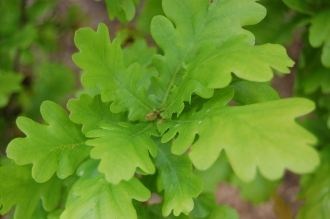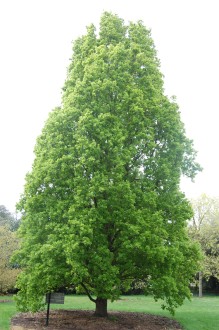Position: Full sun
Flowering period: Mid spring
Soil: Moist, well drained
Eventual Height: 20m
Eventual Spread: 6m
Hardiness: 5a, 5b, 6a, 6b, 7a, 7b, 8a, 8b, 9a
Family: Fagaceae
Quercus robur ‘Fastigiata’ is a medium sized, long lived, columnar deciduous, tree. Its mid green leaves are alternate, simple, lobed and up to 14cm long, with very short leaf stalks, these turn brown/ red in autumn. Its trunk is short and its branches are ascending. Its bark is grey/ brown and fissured, becoming deeply fissured with age. The tree is monoecious, its flowers appear in the form of bright green male catkins and red/ brown female flowers on the end of long stalks. Its fruit is an acorn which is up to 2.5cm long and appear in groups of one to four on long peduncles (stalks) and appear in late summer.
The species Quercus robur, commonly known as English Oak, Pedunculate Oak or French Oak , is native to most of Europe (including the UK), parts of Turkey and north Africa. In its native habitat it usually grows as part of a mixed Oak woodland where it is the dominant species. Quercus robur ‘Fastigiata’, commonly known as Cypress Oak or Fastigiate English Oak, was first discovered growing wild in a German forest and was first propagated by grafting in 1783.
The etymological root of the binomial name Quercus is derived from the Latin name for an Oak tree, but some authorities believe it to be derived from the Celtic quer meaning ‘fine’ and cuez meaning ‘a tree’. Robur is from the Latin meaning ‘might’ or ‘strength’. Fastigiata is derived from the Latin fastigo ‘pointed’, in reference to the habit of this tree.
The landscape architect may find Quercus robur ‘Fastigiata’ useful as a parkland tree, particularly when planted in lines or avenues due to its uniform, upright habit. It is tolerant of some urban pollution and is suitable for street planting where space permits (due to its short trunk). Once established this tree is drought tolerant.
Ecologically, Quercus robur ‘Fastigiata’ supports a high biodiversity of insect herbivores and is therefore very beneficial. The acorns are also a valuable source of food for many mammals and some birds.
Quercus robur ‘Fastigiata’ prefers moist, fertile, deep, well-drained soils. It tolerates most pH of soil and is lime tolerant.
Quercus robur ‘Fastigiata’ requires little maintenance. Pruning of this tree should be carried out during winter to early spring, while this tree is dormant.







Leave a comment